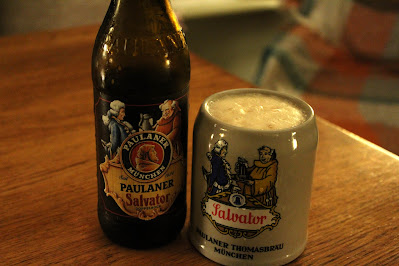All of Klosterbraueri Andechs' beers are new to me, and we start with their helles, which I guess they are calling Andescher Hell. Lo! Melanoidin! Munich malt is presumably the heavy contributor here though the beer is as pale as any other helles, but that intense malted biscuit and light toffee is there, almost suggestive of a darker beer. A great example of what helles should be in contrast to, say, German pils. Bitterness is fairly mild as expected, just a rock solid rounded lager that leans enthusiastically into its Bavarian malt heritage. Dare I say a textbook helles.
Andechs Doppelbock Dunkel pours a clear mahogany, truly a perfect appearance. The aroma is faint enough though, offering only transient whiffs of coppery cola and marzipan. Not the most promising opening for a dark beer of 7.1%, but thankfully its a classic case of under promise, over deliver, because this is rather delicious. Cola dominates again, that softly bittersweet brown sugar and warmly spiced character that is so pleasant in a beer (and indeed a cola). It's also raisiny, but it defies all of these dark and quite rich flavours by remaining quaffable, perhaps dangerously so. This is because the palate is actually quite dry, helping that moreish quality. Which time, it becomes chocolatey, but as the head retention wobbles and fades, you start to notice that the alcohol leaves a tickle of a burn in the throat but, mercifully, not to the sever detriment of the the beer's drinkability. There's even a touch of marker pen in that latent bitterness, another half mark to be docked.

With the head gone, it feels more like a doppelbock than a dunkel, and the alcohol does begin to show, even in the appearance. Compared to the two doppelbocks featured in my previous post it definitely skirts closer to the excellent Illuminator than the Salvator and does display an impressive level of compexity even accounting for its strength, but it's only fair to say that a few of the rougher edges you naturally encounter when making a big beer like this haven't been fully smoothed out.
Still, it's a very pleasant affair that I'd be happy to see again, even if it's not going to be the final word in doppelbock.
Andechs Spezial Hell is a festbier of sorts, according to their website. The strength has been dialled up to 5.9% from the core's 4.8% but I don't see what we're getting for that. Ultimately it's another helles. Not as melanoidiny as the above, showing just sweet grain, soft caramel and a wisp of vegetal bitterness. It's very sinkable, enjoyable and forgettable. That's fine, not everything needs to be remembered. Sometimes a beer is just a beer. That being said, we get more from the 4.8% helles than this rather un-festive festbier.
The standard hell is the pick of the bunch here, but all of these beers are at least worthy of a punt. I look forward to trying any more I come across, extra points granted for beautiful packaging and monkish credentials.








